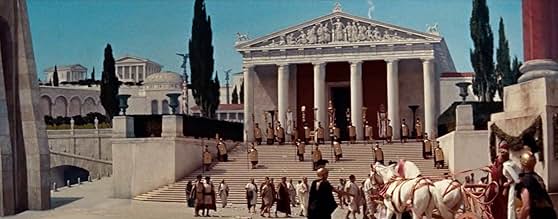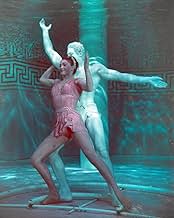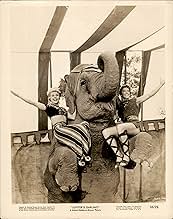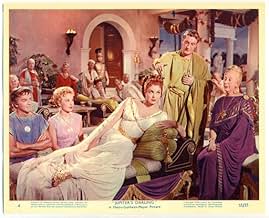NOTE IMDb
5,7/10
742
MA NOTE
Pour sauver la cité de Rome, menacée par les troupes d'Hannibal, la belle Amytis séduit le général carthaginois.Pour sauver la cité de Rome, menacée par les troupes d'Hannibal, la belle Amytis séduit le général carthaginois.Pour sauver la cité de Rome, menacée par les troupes d'Hannibal, la belle Amytis séduit le général carthaginois.
- Réalisation
- Scénario
- Casting principal
Chris Alcaide
- Cpl. Ballol
- (non crédité)
Fred Aldrich
- Soldier
- (non crédité)
Herman Belmonte
- Citizen
- (non crédité)
Ray Beltram
- Slave
- (non crédité)
Stanley Blystone
- Citizen
- (non crédité)
Avis à la une
Believe it or not, there's actually a song whose lyrics sing, "If this be slavery, then give me slavery. If this be slavery, I don't want to be free!" Not only did someone think to write it, but the song was given the green light by Hollywood producers, put into a film, performed by the dance duo Marge and Gower Champion, and not cut from the final film! That should give you an idea as to the quality of music featured in the Esther Williams vehicle Jupiter's Darling.
Esther Williams is engaged to Roman leader George Sanders, but she's drawn to Howard Keel, who's made it his mission to attack and conquer Rome. It's quite a love triangle, because Howard Keel isn't the most likable guy ever written, but he sings powerfully seductive songs and even picks up and moves a real leopard guarding Esther's bed! My one question is why didn't George Sanders get any songs? He showed off his beautiful voice in Call Me Madam, but maybe Hollywood didn't want to give Howard Keel any competition-not that he'd really have any. He's clearly the manly macho one in the movie, and he's scantily dressed, giving audiences an up close and personal view of his macho manliness.
Still, while Howard Keel is able to save a couple of songs in the movie, unless you're an Esther Williams fan, you probably won't end up renting this one. Underwater dancing is a very specialized talent, one that not everyone likes to watch. Then again, you might get a kick out of Richard Haydn sounding very much like his famous Caterpillar role from Alice in Wonderland. Or, you might enjoy looking at Howard Keel in a Greek warrior outfit that barely fits him. One more thing: This is a little criticism, but I do have it-there's a Marge and Gower Champion song performed alongside a couple of elephants, and I couldn't help but feel sorry for the animals. One was supposed to fall over and roll around, while the dancers make fun of it, but to me, it wasn't cute.
Esther Williams is engaged to Roman leader George Sanders, but she's drawn to Howard Keel, who's made it his mission to attack and conquer Rome. It's quite a love triangle, because Howard Keel isn't the most likable guy ever written, but he sings powerfully seductive songs and even picks up and moves a real leopard guarding Esther's bed! My one question is why didn't George Sanders get any songs? He showed off his beautiful voice in Call Me Madam, but maybe Hollywood didn't want to give Howard Keel any competition-not that he'd really have any. He's clearly the manly macho one in the movie, and he's scantily dressed, giving audiences an up close and personal view of his macho manliness.
Still, while Howard Keel is able to save a couple of songs in the movie, unless you're an Esther Williams fan, you probably won't end up renting this one. Underwater dancing is a very specialized talent, one that not everyone likes to watch. Then again, you might get a kick out of Richard Haydn sounding very much like his famous Caterpillar role from Alice in Wonderland. Or, you might enjoy looking at Howard Keel in a Greek warrior outfit that barely fits him. One more thing: This is a little criticism, but I do have it-there's a Marge and Gower Champion song performed alongside a couple of elephants, and I couldn't help but feel sorry for the animals. One was supposed to fall over and roll around, while the dancers make fun of it, but to me, it wasn't cute.
Esther Williams' swan song at MGM is also her final aquatic musical. Less significantly, it's also the last (and best) of the three movies Esther did with Howard Keel. It's a movie that takes place in ancient Rome where Esther plays Amytis, the object of affection for Roman ruler Fabius (George Sanders). Fabius is anticipating an attack on Rome from the famous military commander Hannibal (a bearded Howard Keel). When Hannibal meets Amytis, she tries to use her feminine charms to persuade him not to attack.
It's a silly movie but an enjoyable one that is better than its reputation suggests. The sets and costumes are all colorful and bright, though some today might find it all a bit corny. Esther is fit and gorgeous (those legs!) with a lovely underwater swimming number where she 'dances' with statues that come to life. A real classic and the highlight of the film. She does well in the romantic scenes with Howard Keel, who sings some forgettable tunes. I especially liked that Esther's character was so sexy and fun. Of the three films Keel and Esther did together, this is the one where they have the best chemistry. The cast backing up the leads is solid. George Sanders plays Fabius with as much seriousness as he can muster considering how silly the whole thing must have seemed to him. Richard Hayden is oddly enjoyable as the singing storyteller Horatio. Others in the cast include William Demarest, Douglas Dumbrille, Michael Ansara, and dancing couple Gower & Marge Champion. The Champions perform the "If This Be Slavery" number ("Hooray for slavery!"), which has some lyrics that are funny when taken out of context. Most of the songs and dance numbers are nothing to write home about but none are terrible. Anything with Esther is worth seeing just for her smile...and those legs!
It's a silly movie but an enjoyable one that is better than its reputation suggests. The sets and costumes are all colorful and bright, though some today might find it all a bit corny. Esther is fit and gorgeous (those legs!) with a lovely underwater swimming number where she 'dances' with statues that come to life. A real classic and the highlight of the film. She does well in the romantic scenes with Howard Keel, who sings some forgettable tunes. I especially liked that Esther's character was so sexy and fun. Of the three films Keel and Esther did together, this is the one where they have the best chemistry. The cast backing up the leads is solid. George Sanders plays Fabius with as much seriousness as he can muster considering how silly the whole thing must have seemed to him. Richard Hayden is oddly enjoyable as the singing storyteller Horatio. Others in the cast include William Demarest, Douglas Dumbrille, Michael Ansara, and dancing couple Gower & Marge Champion. The Champions perform the "If This Be Slavery" number ("Hooray for slavery!"), which has some lyrics that are funny when taken out of context. Most of the songs and dance numbers are nothing to write home about but none are terrible. Anything with Esther is worth seeing just for her smile...and those legs!
JUPITER'S DARLING is an offbeat MGM musical with many entertaining elements. Famous as one of the musical flops of MGM's 1955 output (which included KISMET and IT'S ALWAYS FAIR WEATHER)which all but ended the MGM musical -as well as the contracts of some of its major participants- the movie generally received critical praise in its day and still has a "fan base" today. The credits for the film are eye-opening.It is based on a landmark play of 1927 entitled THE ROAD TO ROME which dealt humorously with Hannibal's march on Rome but was in fact a plea against war.It's author, Robert Sherwood, died the year of the film's release and amongst his other stage and screen work are titles such as The Petrified Forest,Idiot's Delight, Rebecca and The Best Years of Our Lives.Though much changed to accommodate the aquatic talents of Esther Williams and the form of the screen musical, generous amounts of Sherwood's witty and even racy dialogue survive. At a time when the period epic was in its full CinemaScope bloom (egs. THE ROBE, THE Egyptian) it's refreshing to see the genre being lampooned in such a tongue-in-cheek manner. Esther even spoofs her own underwater ballets in the I HAD A DREAM sequence (the best song in a somewhat underrated Burton Lane score)and has another dramatically exciting underwater scene in a later reel. Vocally strong as ever,Howard Keel is robust and virile as Hannibal (who in one funny scene reveals a fear of water and an inability to swim-surely an "in-joke" considering his co-star!)and the supporting cast (Marge and Gower Champion,George Sanders,Norma Varden,William Demarest and Richard Hayden) all get great moments. The direction is by one of MGM's best musical directors, George Sidney (The Harvey Girls, Show Boat, Pal Joey) and the inventive wide screen cinematography is by Paul C. Vogel and Charles G.Clarke,two of the best D.P.'s of the day. (Clarke shot CAROUSEL for Fox magnificently one year later).Written for the screen by MGM contractor Dorothy Kingsley (Seven Brides,Kiss me Kate)and budgeted at possibly the biggest figure for an MGM musical at that time, the film is a visual stunner with unique merits which outweigh its flaws.(One complaint- MGM cut the reprise of I HAVE A DREAM by Williams(dubbed) and Sanders (not dubbed) which was followed by a sizzling dance by the Champions.A faded out-take on the laserdisc edition at least allows buffs to view this now!)
A legendary MGM flop, one of the big musicals reputed to have helped kill off big musicals. And it's pretty silly in spots, with a buff Gower Champion singing lyrics like "If this be slavery/ I don't want to be free!" and song-and-dance cues arriving perfunctorily. But it's also an enterprising effort at keeping a dying genre alive, with plenty of sung-lyric exposition by Richard Haydn as a bewildered historian, and more plot-song integration than most MGM musicals attempted. It's also sexier than the average musical, quite frank about why Hannibal kept delaying his attack on Rome, and with plenty of chemistry between Esther Williams and Howard Keel in the main plot and the Champions as the secondary, comic-relief couple. The Burton Lane-Harold Adamson songs aren't great, but they aren't terrible, and for such a huge production, it's surprisingly light on its feet and irreverent. There's a fairly exciting, well-edited chase-through-the-water climax, and if Dorothy Kingsley's screenplay doesn't achieve the Shavian heights it's attempting to scale, it's smarter than most musical screenplays of the day. The wide screen is well filled, and the thing moves quickly. Well worth a look.
Historically hysterically satirical, this showcase for the swimming talents of Olympian-turned-actress Esther Williams and the vocal talents of the great Howard Keel, is ostensibly set in the Roman Empire but reeks of 1950s Hollywood. Based on the landmark 1927 play "The Road to Rome" by the great Robert Sherwood, this movie did not fare well at the box office, but the reason may be that it was too racy, the lyrics and dialogue too ironic for the times. Dealing humorously with Hannibal's march on Rome, the story line is really a plea against war and features a gloriously athletic Williams driving a chariot, looking like Wonder Woman, and escaping her pursuers in a breathtaking underwater chase scene. Marge and Gower Champion's dance sequences are equally athletic and mesmerizing, especially their dance with Hannibal's elephants. While the songs may not be particularly memorable, the lyrics are often hilarious, especially "If This Be Slav'ry" and "Never Trust a Woman." The narration sung/spoken by Richard Haydn is also an amusing touch. The film opens with a caveat that sets the tone: "In 216 B.C., Hannibal the Barbarian marched on Rome. The history of this great march has always been confused. This picture will do nothing to clear it up."
Le saviez-vous
- AnecdotesWilliams refused to do the scene where Amytis rides a horse off a cliff and MGM refused to cut the scene. Platform diver Al Lewin did the stunt in one take - and broke his back in the process.
- GaffesDuring the "slave market" dance number Marge Champion at one point has a small basket on her head. It falls off and lands on the ground between her and Gower. They pull in for a closeup and when they pull back the basket is gone.
- Crédits fousIn opening credits: "In 216 B.C., Hannibal the Barbarian marched on Rome. The history of this great march has always been confused. This picture will do nothing to clear it up."
- ConnexionsFeatured in 1955 Motion Picture Theatre Celebration (1955)
- Bandes originalesHoratio's Narration
(uncredited)
Music by Saul Chaplin
Lyrics by George Wells, Harold Adamson and Saul Chaplin
Sung by Richard Haydn
Meilleurs choix
Connectez-vous pour évaluer et suivre la liste de favoris afin de recevoir des recommandations personnalisées
- How long is Jupiter's Darling?Alimenté par Alexa
Détails
Box-office
- Budget
- 3 337 000 $US (estimé)
- Durée
- 1h 35min(95 min)
- Rapport de forme
- 2.55 : 1
Contribuer à cette page
Suggérer une modification ou ajouter du contenu manquant



































